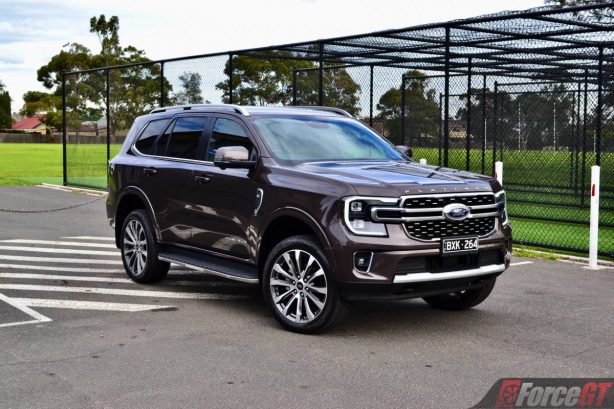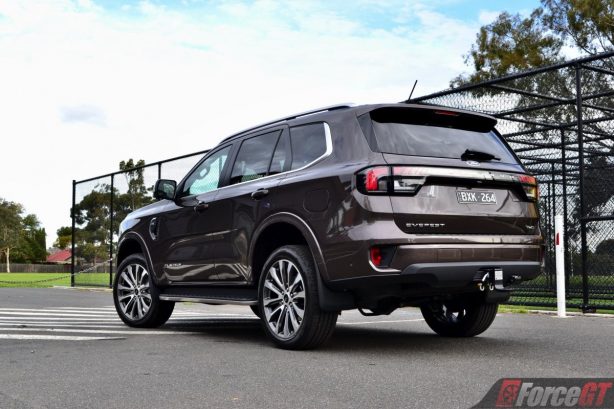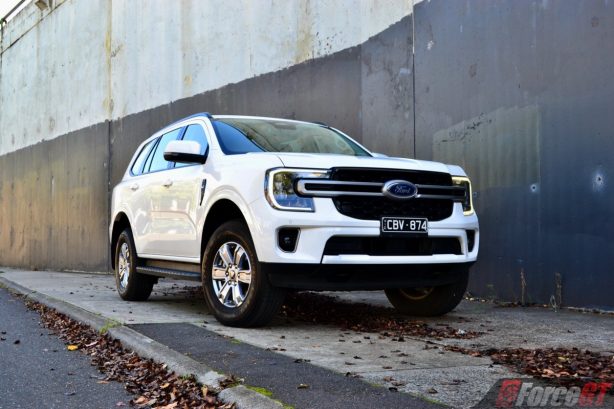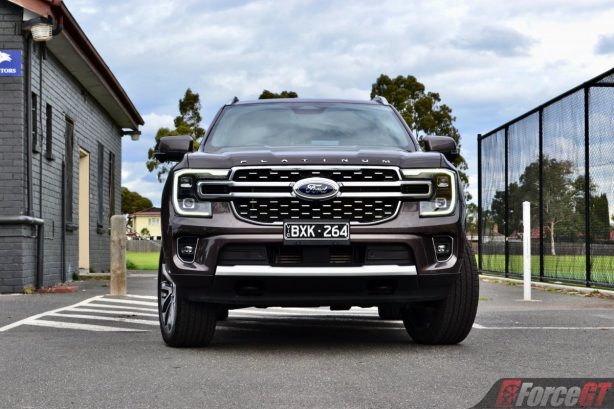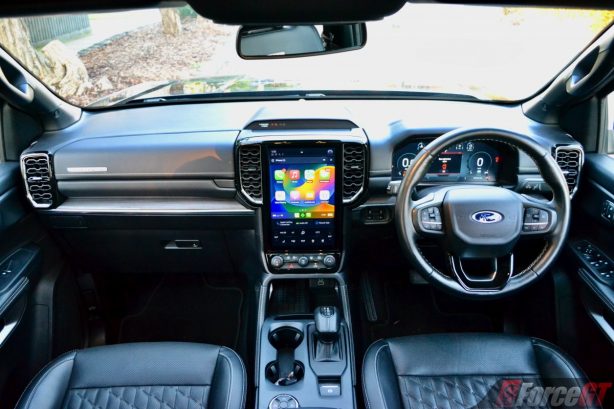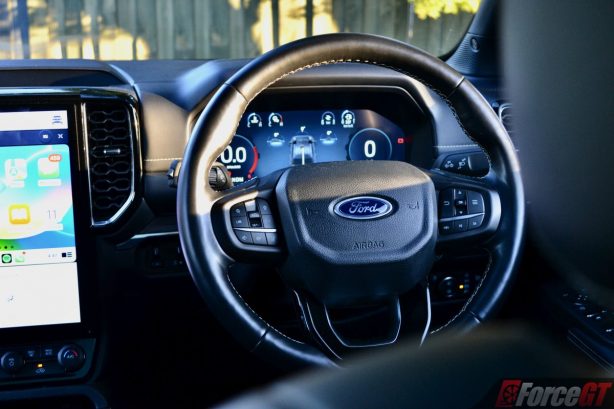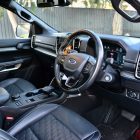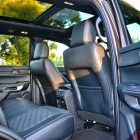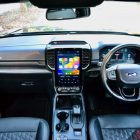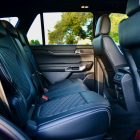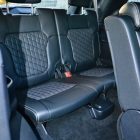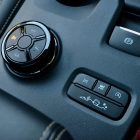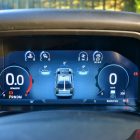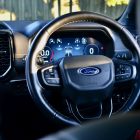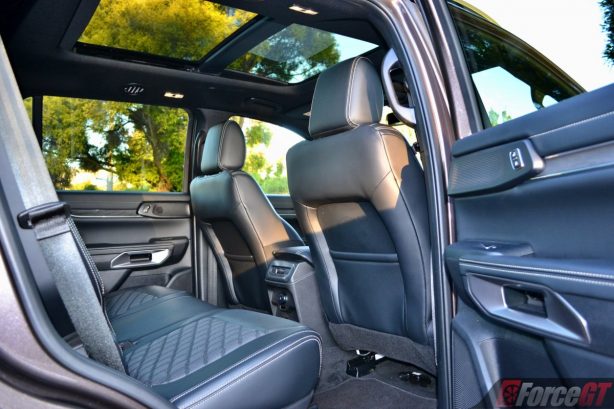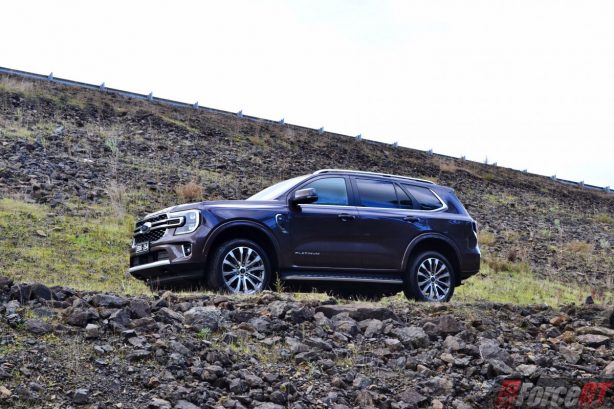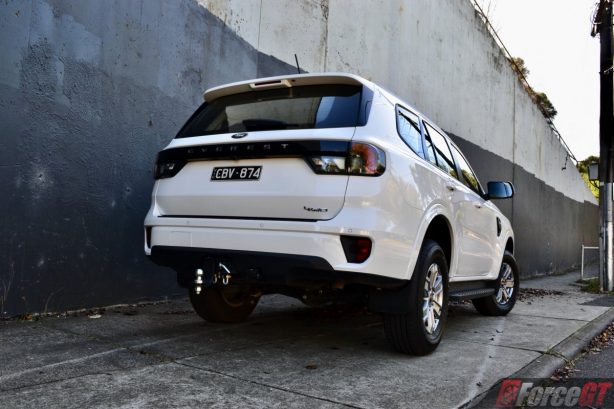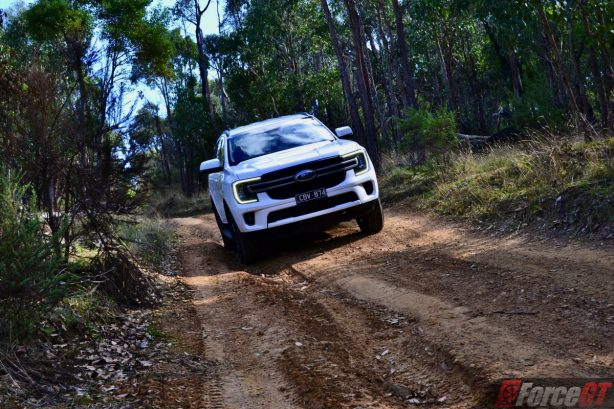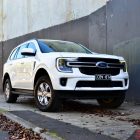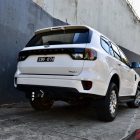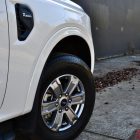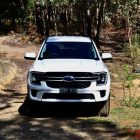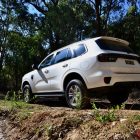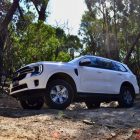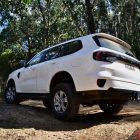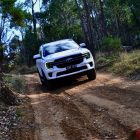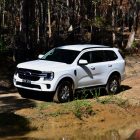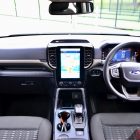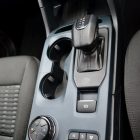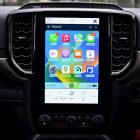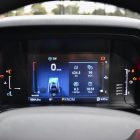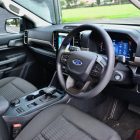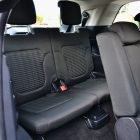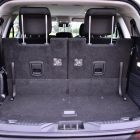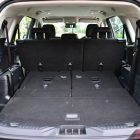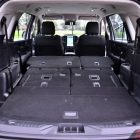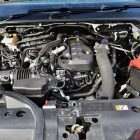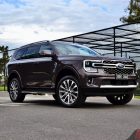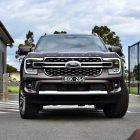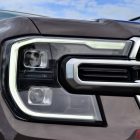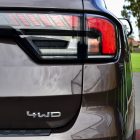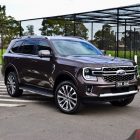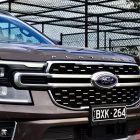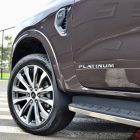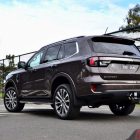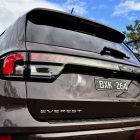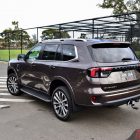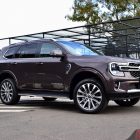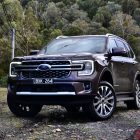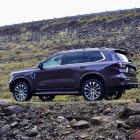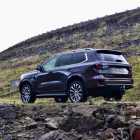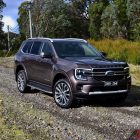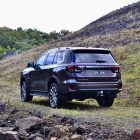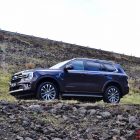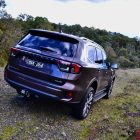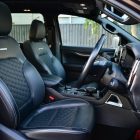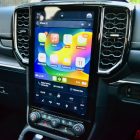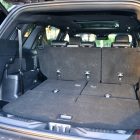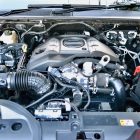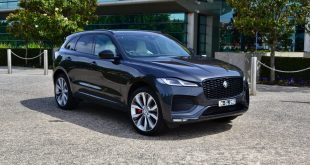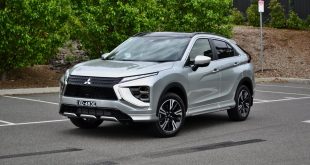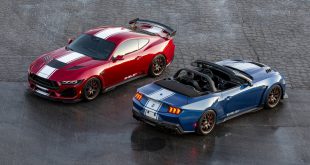At the pointy end of the large 4×4 SUV segment there’s the Ford Everest and there’s the Everest’s long-time rival the Toyota LandCruiser Prado. Previous generations of Everest had mostly lived inside the shadows of the Prado, mostly because the latter was a little more refined, more luxurious and had a richer heritage.
For the latest third-generation Everest however, Ford has up their game – enormously. For starters, the company has engineered both the Ranger Ute and Everest concurrently rather than having the Everest’s development followed behind the Ranger. As such the new Everest comes across as a more cohesive model, having been developed ‘from the ground up’ as a 7-seater large 4×4 and not merely a wagoned-body Ranger with more seats.
The Blue Oval has also loaded the Everest with the latest technology, strengthened its safety and stuffed a new, gutsier V6 diesel under the bonnet. It rides on a new Ford Australian-developed T6.2 platform with a modular-style ladder chassis design. There’re heaps more underbody protection and the dynamic roof load capacity has improved to 100kg (350kg static).
It’s as if Ford is saying ‘Prado, I’m totally coming for you this time’. And in all honestly, the aging Prado does feel massively left behind by this new, much more advanced Everest. But an all-new Prado will land in early 2024 and the Everest ought to be spectacular to continue the challenge.
How much does the Everest cost?
Prices for the Everest have increased over the previous generation model, with each variant across the line-up seeing a hike of around $3,000. The range starts from $53,290 with the Ambiente RWD 2.0-litre Bi-Turbo Diesel and stretches to $77,530 for the flagship Platinum 3.0L V6 Turbo Diesel. All prices exclude on-road costs.
There’s a host of available options, including a $1700 towing pack, a $950 third row addition to the Ambiente grade (fitted to vehicle on test), a $900 premium seat pack for the Trend grade and an all-terrain tyre pack offered as a no cost option ($1100 for Ambiente).
As mentioned, the new Everest plays at the higher end of the segment, with the line-up costing more than less expensive rivals like the Mitsubishi Pajero Sport and Isuzu MU-X. That said, the Everest is still slightly more affordable than the Prado, which in its range-topping grade costs a hefty $87,500 plus ORCs.
How does the Everest look?
Ford’s reborn off-roader, the Bronco seems to have influenced the company’s latest 4×4 styling. But that’s fine as it’s worked wonders. The new Everest looks purposeful and tough as it is upmarket and classy. The bold front fascia has one of the most prominent grilles we’ve seen in a Ford model and certainly the largest Ford badge ever. The C-shape daytime running lights further add to the strong frontal visual statement.
There’s effective use of creases and lines throughout the side of the vehicle to break up and lighten up the otherwise large side canvas. The rear emphasises the stretched light bar with the name Everest proudly spelled across the middle.
LED lighting all around is standard across the range, while wheel sizes of 17 inches to 21 inches are fitted depending on the grade level.
For those keen on sportier looks, the mid-spec Everest Sport offers black exterior accents with matching 20-inch black wheels. The recently added Everest Wildtrak special edition model aims at those who want a tougher look, bringing with it a ‘H-bar’ bumper, stand-off roof rails and exclusive Wildtrak badging which are further differentiated by the Luxe Yellow exterior body paint job.
What is the interior of the Everest like?
The cabin of the latest generation Ford Everest is where improvement is the most significant. There’s a big step up in presentation, quality and fit and finish, with the interior of the Trend model and up feeling properly upscale. That of the top-spec Platinum model feels even more plush and rich.
The dash has been totally redesigned and now incorporates a massive 12.0-inch centre touchscreen display from the Trend grade and up. The base Ambiente has a smaller 10.1-inch screen. The high resolution touchscreen, which runs Ford’s latest Sync 4 OS, has an excellent layout and menu structure, however some on-screen buttons are too small and the fiddly scroll bar required to operate the seat heating can be difficult to use when on the move. The screen’s responsiveness to the touch can also be improved.
Crucially, Ford has maintained the use of physical knobs and buttons for the all-important climate control as well as media on/off and volume functions. All other features including built-in satellite navigation, digital radio, Apple CarPlay and Android Auto (both wireless across the range) are operated through the touchscreen.
Wireless Apple CarPlay connects automatically and swiftly each time you hop in the car. Frustratingly though, it occasionally drops out. For a more stable connection you might need to resort to using a USB connecting cable. Speaking of which, USB A and USB C ports are available to both front and second row occupants. A wireless charging pad is fitted in the centre console.
All models get an 8.0-inch digital instrumentation cluster which is rather small and quite basic, but the larger 12.4-inch display found in the Platinum means business with better clarity and a greater level of customisation. However, map view is not available in both display sizes.
All Everest models except for the Ambiente have 7 seats. The Ambiente tested here is fitted with the optional $950 3-Row Seat Pack. There’s plenty of space in the first and second row seats. The third row is best reserved for kids as adults will find it lacking foot and knee room. If you must carry adults back there you can slide the second row seat forward slightly for more leg room. Access to the third row is manageable, with the passage liberated by pulling a lever that slides and tilts the second row fully forward.
Practicality is good with the dash fitted with not one but two gloveboxes. The sizable centre compartment offers additional storage space, and the door pockets are thick enough to accommodate bottles. Each seat bar the middle second row gets its own cup holder.
Further back, the boot measures 259 litres with all seats up – good enough still for a small pram or a couple of small bags. Drop the third row and the space expands to 898 litres, and further to a voluminous 1823 litres with the second row also stowed. In this configuration the boot floor is flat (almost), making it easy to load and move items around the boot. However, models with powered tailgate have the boot light positioned right next to the boot close button. This is blinding at night, making it hard to find the close button.
How does the Everest drive?
Ford’s versatile 2.0-litre twin-turbo four-cylinder diesel engine continues to power the Everest in the Ambiente, Trend and Sport models. It’s been carried over from the previous generation albeit tweaked and enhanced to deliver better refinement. It outputs 154kW at 3750rpm and 500Nm at 1750-2000rpm.
The 2.0-litre diesel is mated to a 10-speed automatic transmission, also caried over but upgraded with a new torque converter and retuned shifting algorithm for smarter gear selection and smoother shifts. This engine/gearbox combo is one of the best in the segment, delivering strong performance that is as responsive in the city as it is effortless on the freeway.
The 3.0-litre V6 turbo diesel is more muscular but it’s a pity that it’s only fitted to the more expensive Sport, Wildtrak and Platinum models. The smoother and quieter V6 certainly serves up a more relaxing and luxurious driving experience, and although the 2.0L models match the 3.0L variants with a rated 3500kg towing capacity, it’s the latter that deliver a stronger pull when the car is loaded to the brim or going uphill.
Regardless of which engine is under the bonnet, the Everest continues to be one of the best riding large SUVs on the market. Patchy roads are handled with admirable compliance and its ute underpinnings never once rear its agricultural head. The Platinum is a little busier on bad roads than its lesser siblings most likely due to the larger wheel size with lower profile tyres. Cabin refinement in the 2.0L models is good, while in the 3.0L variants it’s simply exemplary thanks to the smooth and lazy V6.
For a heavy and high riding vehicle, the Everest is pretty manageable around the bends. Being Australian-developed, the handling in particular is well suited to Aussie roads and landscape. Again the ladder-frame platform is well disguised and the dynamics are more akin to a monocoque SUV, with good body control and direct steering.
Off the beaten track, the Everest is one of the more capable 4x4s out there. The independent suspension setup is augmented by a variable four-wheel drive system with selectable drive modes (V6 models) and low range. Instead of a conventional locking centre differential, the Everest’s 4×4 uses an electronically controlled clutch pack that’s capable of splitting drive equally between the front and rear axles (4H mode). A locking rear differential further adds to its off-road potential.
There’s good wheel articulation, maintaining traction across all but the trickiest of terrain, and if a wheel does come off the ground the locking differentials do an excellent job in getting it going again. If you do regular or heavy off-roading, the Platinum’s 21-inch wheels and tyres may not be appropriate. Opting for 18-inch wheels and all terrain tyres is recommended, not only for better traction but also to optimise ride comfort, as even with thicker tyres on smaller wheels the Everest can feel jittery on pimply gravel tracks.
What is the maintenance cost of the Everest?
The Everest comes with a 5-year/unlimited kilometre warranty.
In terms of servicing the Everest requires a visit to the dealer every 15,000km or no longer than 12 months, whichever comes first. Servicing cost for the first 4 visits is capped at just $329 per visit.
Combined cycle fuel consumption is rated at 7.2L/100km for the 2.0L Bi-Turbo and 8.5L/100km for the 3.0 V6. On test with a mixed of roads traveled including an off-road stint, the 2.0L Bi-Turbo Ambiente managed 8.5/100km, while the 3.0 V6 Platinum returned a much thirstier 10.9L/100km.
Verdict
Design & Comfort
Performance & Handling
Quality
Economy
Equipment & Features
OUR SCORE
4.0/5
+ Plus
- V6 refinement and quietness
- Well-presented cabin with advanced tech
- Admirable ride and handling balance
– Minus
- Unstable wireless Apple CarPlay connection
- Jittery ride on off-road surfaces with high frequency bumps
- Touchscreen response laggy at times
Overall
Ford has up the ante considerably with the third-gen Everest. The previous model was already quite good, but the new one has elevated to a whole new level. It drives better on and off road, is well specified across the range and has a vastly improved interior.
The V6 is superior in terms of smoothness and towing capability, but the more economical 2.0L Bi-Turbo is just as well sorted for the daily grind plus more.
For now, the Everest is the segment’s lead. But the real fight comes when the new-gen Toyota LandCruiser Prado hits our shore in early 2024.
2023 Ford Everest pricing and specification
| Price (Excl. on-road costs): | From $53,290 to $77,530 As Tested: $59,440 (Ambiente 4×4 with 3rd row seat addition) $77,530 (Platinum) |
| Country of Origin: | Thailand |
| Warranty: | 5 years / Unlimited km |
| Service Intervals: | 12 months/15,000 km |
| Engine: | 2.0-litre bi-turbo diesel: 154kW @ 3750rpm; 500Nm @ 1750-2000rpm 3.0-litre V6 turbo diesel: 184kW @ 3250rpm; 600Nm @ 1750-2250rpm |
| Transmission: | 10-speed automatic |
| Drivetrain: | All-wheel drive |
| Fuel Consumption (L/100km): | Ambiente: Claimed: 7.2 / Tested: 8.5 Platinum: Claimed: 8.5 / Tested: 10.9 |
| Fuel Tank Capacity (L): | 80 |
| Body: | 5-door wagon |
| Seats: | 5/7 |
| Safety: | ANCAP 5 star, 8 Airbags, AEB, Lane Keeping Aid with Lane Departure Warning, reversing camera, blind spot monitor with cross-traffic alert, adaptive cruise control, Traffic Sign Recognition, Hill Start Assist |
| Dimensions (L/W/H/W-B) mm: | 4,940/1,923/1,841/2,900 |
| Tare Mass (kg): | 2,394-2,432 |
| Entertainment: | 10.1/12.0-inch touchscreen infotainment system, AM/FM/DAB+ audio with 10 speakers (12-speaker premium audio for Platinum), Apple CarPlay/Android Auto |
| Towing Capacity (kg): | Braked: 3500, Unbraked: 750 |
 ForceGT.com Car News, Car Reviews, Video Reviews, Tuning and much more.
ForceGT.com Car News, Car Reviews, Video Reviews, Tuning and much more. 